You know how life just goes on, it doesn’t wait if you’re falling behind? Yea? Ok, that’s been my life for the past few months. But, we’re not here to talk about parental fatigue, ‘too much to do and not enough time’ syndrome, or just plain tiredness. What I did want to talk about is part of what brought us here and now.
I remember when Dexter was born. My husband was stationed at Fort Campbell, KY, we wanted him to be born in a civilian hospital, so Gateway it was in a nearby town. They took him for a newborn screening and didn’t bring him back for a while. I was getting antsy. I wanted my baby I just birthed. The doctor came in. Looked me in the eyes and said they believe he has Down Syndrome.

Many moves across the country, specialists, procedures, tests, therapists and therapies, we fast forward to a year ago. We are told that they suspect autism. More tests, specialists later, we have a diagnosis. So, among other acronyms, our little (big!) guy has a dual diagnosis. All the sensory seeking behaviors really make sense now.
This brings us to us deciding to make sensory and teething jewelry. Dexter is my number one reason for making the sensory and fidget jewelry. He is my first tester and he and his younger brother test the durability (shall we say, quality control?).
Right now, our biggest thing we are working on is with dexter chewing on fingers. We are using the sensory chewing necklace to help with sensory input and chewing on more appropriate items. Since we just recently had these tested at an independent lab, we know for sure they are 100% safe and non toxic. What is great is that we keep on at school and one at home, so he always has one handy.
Having a necklace at the ready that he can chew on when he needs the extra input is better and safer than Dexter chewing on a pen or his fingers. It hangs on his neck and is less likely to touch germy floors or desks or doors or shoes. The break away clasp adds another safety feature: It will break open when it’s pulled. The necklace has also been incorporated in the classroom by the teacher and in our ABA therapy at home.
Alice
